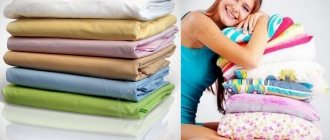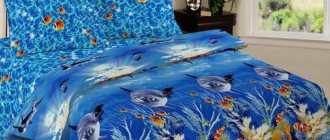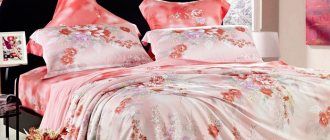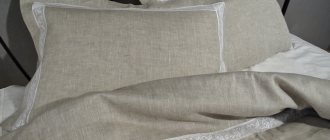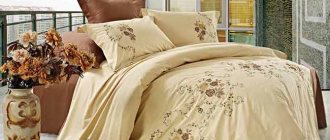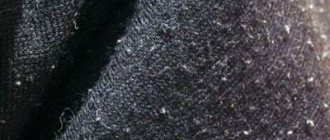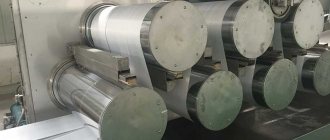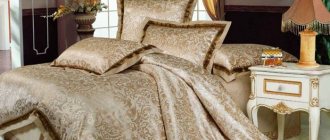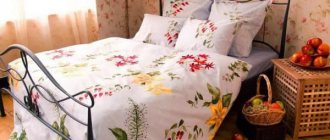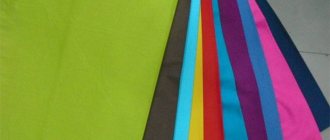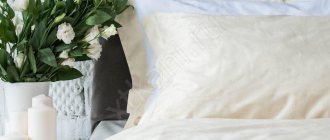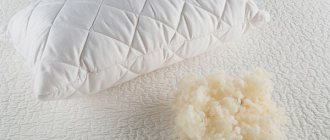Home / Blended fabrics
Back
Published: 12/02/2020
Reading time: 2 min
1
132
Microsatin is an innovative material that has already gained popularity in the textile market. The fabric combines natural and synthetic fibers, which ensures its strength, wear resistance, lightness, and the ability to maintain the brightness of colors throughout the entire period of use. Therefore, microsatin bed linen is in high demand among consumers, as it has excellent quality and an affordable price. But in order for the material to retain its properties, you need to know the features of caring for it.
- 1 Features of the material
- 2 Composition
- 3 Pros and cons
- 4 Use
- 5 Care
- 6 Reviews
- 7 Conclusion
Features of the material
Microsatin fabric is a thin fabric consisting of two types of threads: natural and synthetic. Their production takes place on special equipment, since the diameter of each does not exceed 0.1 mm. This is achieved through mechanical devices that force natural threads into small holes, after which they are cooled and separated into fibers. And at the next stage, synthetic threads are woven between them. The result is a fabric with microscopic voids, which ensures its moisture-absorbing properties.
In appearance, the material resembles silk, as it is characterized by smoothness and shine. But at the same time it is light, pleasant to the body, and its density is 120 g per square meter. m. Absorption of the fabric contributes to its uniform coloring and color fastness over a long period of time, regardless of the number of washes.
The use of 3D prints on microsatin has become very popular. This made it possible to expand the range of bed linen and increase demand among consumers, as voluminous designs look original.
Fact! In the production of microsatin, a double weaving technique is used with alternating natural and synthetic threads.
What is microsatin
Microsatin fabric looks like silk. It is characterized by smoothness and shine. Textiles are usually made from synthetic and natural fibers in a ratio of 2:3, respectively. Weaving the fabric itself involves alternating two types of threads.
The textile composition contains:
- Polyester, viscose, giving it durability and color fastness.
- Natural satin (fabric made of silk and cotton), responsible for softness and tenderness.
- In cheaper fabrics, cotton and silk are replaced with bamboo fibers.
Sometimes the fabric is made from 100% polyester. It is very stable, durable and bright. But at the same time there is no characteristic smoothness and softness.
Microsatin is a lightweight, soft textile. Its density is only 120 g/m2.
The production of the material has the following features:
- The threads of the fabric are tightly twisted.
- Textiles are made using double weaving technique, alternating synthetic and natural threads.
The material differs from ordinary satin in its composition. It is made from 100% natural fibers (cotton and silk), while microsatin is slightly more than half synthetic. This makes the material more stable in color, durable, practically wrinkle-free, and affordable.
View this post on Instagram
Posted by Last Minute Tours (@ufa_postel) Aug 8, 2021 at 2:20 PDT
Compound
The fabric contains two types of fibers. The ideal ratio is 60% to 40%, where the first number means the content of natural threads, and the second – synthetic. This proportion is often found in microsatin fabric, which is used for bed linen. The textile composition includes natural satin, which is made from cotton and silk. These fibers make the material soft and gentle to the touch.
To reduce the cost of production, it is possible to replace satin with bamboo fibers.
Synthetic threads in microsatin can be represented by polyester and viscose. They ensure the durability of the material and durability of bright colors. But there is also fabric on sale with 100% synthetic fiber content.
This composition reduces its cost, increases wear resistance, and also helps maintain shape. But bedding made purely from synthetic fabric does not have a pleasant softness, tenderness, and it is also electrified.
Advice! Products made from this material may differ in quality, depending on the content of natural threads, so when purchasing you need to carefully study the composition.
Difference from regular satin
Factories that sew underwear sets often use fabrics like satin, calico, poplin, and ranfors. If no questions arise with a composition where 100% cotton is used, then with the word microsatin questions arise.
According to standards, satin is made from natural silk or cotton. The surface of the canvas is smooth and slippery, more pleasant to the tactile sensations.
Synthetic fibers (for example, polyester) are added to the composition of microsatin, which increases the shelf life, the material wrinkles less and significantly reduces the cost of manufactured products, making them affordable for any wallet.
Advantages and disadvantages
Microsatin has a number of advantages, and first of all it is the affordable cost of products based on it. But the material also has certain disadvantages that need to be taken into account.
Pros:
- strength;
- ease;
- increased wear resistance;
- silkiness;
- dries quickly;
- does not form creases;
- does not shrink;
- hygroscopicity and breathability;
- does not shed;
- crush resistance;
- absence of pellets;
- Retains durability of bright colors.
The disadvantage of microsatin is that it creates a feeling of coolness, which is not always appropriate in winter. It should also be noted that this fabric has a narrow scope of application.
Description and properties
Technologies do not stand still, but are constantly evolving. The 20th century taught us to obtain artificial raw materials and widely use them for weaving. In our world, there are a vast number of types of matter, which are united by a structural thread that is micron thick. Fabric made from microfibers has the following advantages:
- soft to the touch;
- absence of pellets;
- lightweight products;
- hypoallergenic;
- does not wrinkle or shrink;
- products do not fade;
- hygroscopicity;
- long wear resistance;
- dries quickly after washing;
- painted in bright colors.
In addition to the listed advantages, microsatin resembles silk. Bed sets are mainly made from fabric. Their smoothness, affordability and durability increase consumer demand. The dyeing option allows you to print bright colors that decorate your bedroom interior.
Usage
Microsatin is mainly used for sewing bed linen. This textile is hypoallergenic, so it is suitable even for people with sensitive and delicate skin. Bath towels with increased absorbency are also made from this material.
Author:
Anastasia Kukushkina
I hope you enjoy the article I have prepared for you! If you find errors in it, write to me about it! I will answer any questions you have, ask them!
